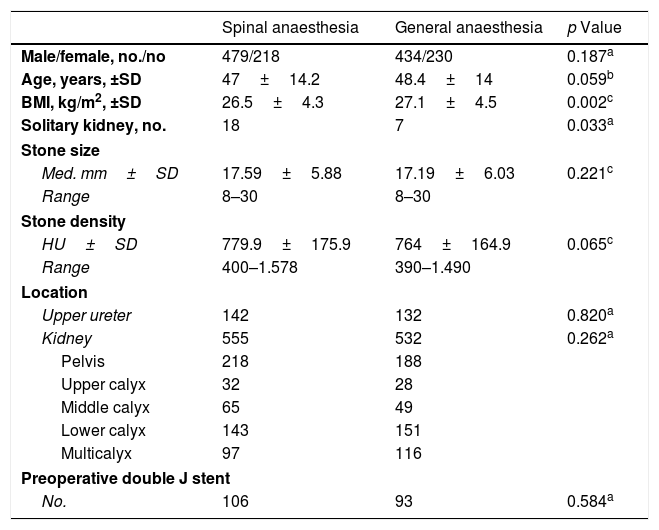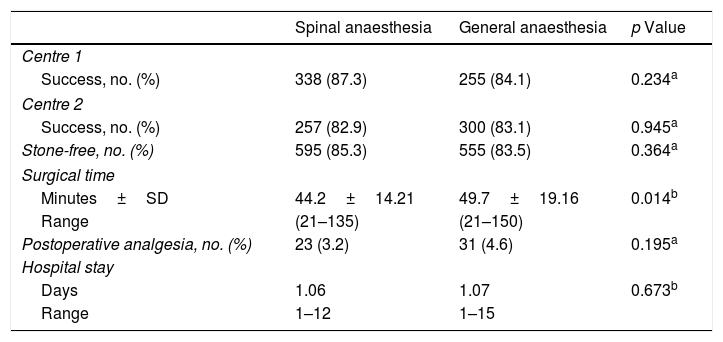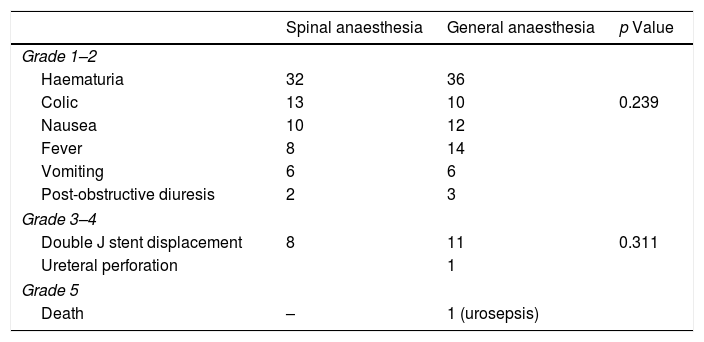The aim of the present study was to compare RIRS procedures applied under general anaesthesia (GA) and spinal anaesthesia (SA) regarding success and complication rates.
Materials and methodsA retrospective evaluation was conducted with the data obtained from patients treated with RIRS under SA and GA at 2 centres from October 2014 until January 2018. The SA and GA groups were evaluated according to the parameters of stone-free and complication rates, postoperative pain control and length of in-hospital stay. The stone-free rates from the RIRS procedures applied with SA were evaluated by the surgeons who participated in the study.
ResultsA total of 1361 patients were included in the study. A stone-free rate of 84.4% was obtained in the global results: 85.3% in the SA group and 83.5% in the GA group (p=0.364). No statistically significant difference was determined regarding surgeons who practiced RIRS under SA with respect to success/complication rates and operating time (p=0.676). Operation time was determined as 44.2±14.2min in the SA group and 49.7±19.1min in the GA group (p=0.014).
ConclusionsThe RIRS method can be applied safely, either under spinal anaesthesia, or under general anaesthesia. The success of RIRS under spinal anaesthesia has been shown as an independent factor regarding surgeon. It can be considered a good alternative to general anaesthesia.
El objetivo del presente estudio ha sido comparar los procedimientos de CRIR realizados bajo anestesia general (AG) y anestesia espinal (AE) con respecto a las tasas de éxito y las tasas de complicaciones.
Materiales y métodosSe ha realizado una evaluación retrospectiva de los datos de los pacientes tratados con CRIR bajo AG y AE en 2 centros, entre octubre del 2014 y enero del 2018. Los grupos de AG y AE han sido evaluados con respecto a los parámetros: libre de cálculos, tasa de complicaciones, control del dolor postoperatorio y duración de la estancia en el hospital. Los cirujanos que participaron en el estudio examinaron las tasas de ausencia de cálculos de los procedimientos de CRIR bajo AE.
ResultadosUn total de 1.361 pacientes fueron incluidos en el estudio. Se obtuvo una tasa libre de cálculos del 84,4% en toda la muestra, el 85,3% pertenecientes al grupo tratado con AE y el 83,5% al grupo de AG (p=0,364). No se determinaron diferencias estadísticamente significativas entre los cirujanos que llevaron a cabo la CRIR bajo AE con respecto a las tasas de éxito y complicaciones y el tiempo quirúrgico (p=0,676). El tiempo quirúrgico se determinó como 44,2±14,2 min en el grupo de AE y 49,7±19,1 min en el grupo de AG (p=0,014).
ConclusionesLa CRIR se puede llevar a cabo de forma segura, tanto con AE como con AG. Se observó que el éxito de la CRIR bajo AE era independiente del factor relacionado con el cirujano, por lo que esta puede considerarse una buena alternativa a la AG.










